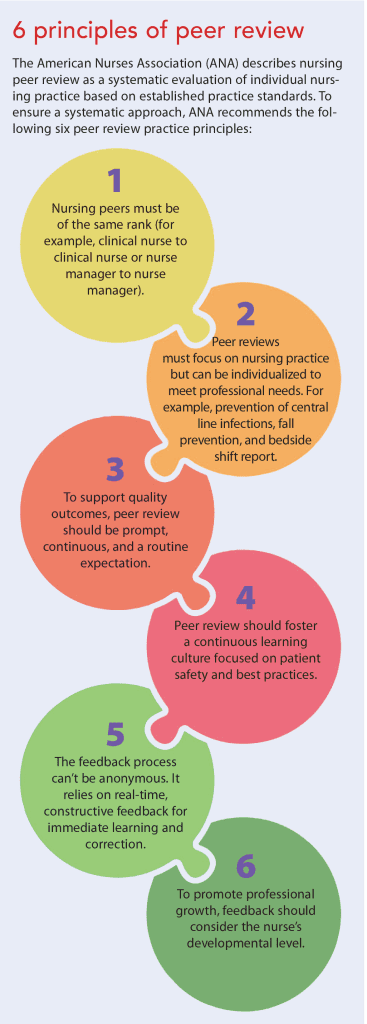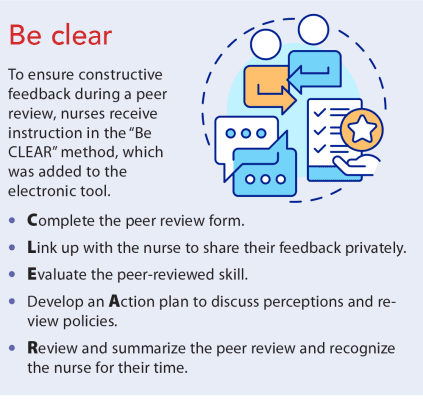A new tool enhances engagement and improves compliance.
- Peer review, an expectation of nursing professionals, aligns with Magnet® standards related to the promotion of patient safety and the advancement of nursing knowledge.
- When a Florida hospital experienced an increase in central line–associated blood stream infection (CLABSI), it implemented a quality improvement project related to its peer review process.
- Switching from a manual to an electronic tool increased compliance with the peer review process, which aided a decrease in CLABSI.
Peer review, an expectation of nursing professionals, aligns with Magnet® standards related to the promotion of patient safety and the advancement of nursing knowledge. In 2016, in preparation for its Magnet application, Orlando Health Orlando Regional Medical Center (Orlando Health) implemented a nursing peer review process for all nursing units. However, in 2021, compliance issues resulted in an increase in central line–associated blood stream infection (CLABSI) in the surgical oncology progressive care unit. To address this challenge, the organization implemented a quality improvement project related to its peer review process. (See 6 principles of peer review.)
Orlando Health bases its peer review process on Haag-Heitman and George’s theoretical nursing framework for nursing peer review. This accountability-focused conceptual model includes four components of peer review: responsive environment, shared decision-making, personal empowerment, and transformational management.
Central vascular access device complications:
Central lines: Recognizing, preventing, and troubleshooting complications


The challenge
Compliance issues with the peer review process indicated that Orlando Health’s traditional nursing peer review checklists required improvement. The organization completes nursing peer review every 3 months on a topic demonstrably in need of improvement. We also use nursing peer review to address urgent nursing practice-related quality issues, such as increases in hospital-acquired infections, compliance with bedside shift report, falls reduction, and pressure-injury prevention.
The traditional process uses paper checklists to conduct and document completion, a time-consuming practice for participants and the UNPC chair. After manually collecting completed checklists from each nurse who participates in a peer review, the chair then creates a summary report for compliance monitoring. Some of the most common challenges to successfully using the paper checklists include misplaced checklists, running out of copies, and lack of time for effective completion.
Orlando Health’s surgical oncology progressive unit, which has 30 inpatient private beds, 36 staff nurses, and 14 nursing assistants, typically has a 4:1 nurse-to-patient ratio. Some oncology patients require central lines due to the complexity of cancer care and for I.V. chemotherapy or total parenteral nutrition. The unit’s CLABSI rate significantly increased in January 2021 to 5.35 per 1,000 device days. In discussing these results, the UNPC discovered that a lack of standardization of central line management played a role. Organizational protocols existed, but the process wasn’t standardized or efficient.
The UNPC decided to use nursing peer review to standardize nursing practice and move to an electronic tool. Orlando Health requires that nursing content experts participate in the development or review of all peer review tools before implementation. The UNPC chair, in collaboration with various stakeholders (the Magnet program director, other nursing content experts, direct leadership, and UNPC members), developed an electronic nursing peer review tool using Microsoft Forms. The tool mimics the CLABSI paper checklist, which included current standards and evidence-based practice for central line–infection prevention, such as intact dressing, indication for the central line, chlorhexidine bath completion, proper I.V. tubing labels, and changing and cleaning all caps and access points.
The improvement process
Nurses can access the electronic CLABSI nursing peer review tool via their mobile phones using the QR code posted on computers and bulletin boards in various locations. For those who prefer to access the form using a URL, the UNPC chair shares a link to the tool via email. No matter how peer reviewers access the online form, they complete it in the same way they would the paper checklist, answering “yes,” “no,” or “not applicable” based on their findings.
The electronic tool automatically compiles and summarizes data and creates pie charts of each peer review question and the respective responses. To check compliance, the UNPC chair downloads and saves a roster of the nurses who complete the tool. The chair then shares a summary of all completed peer reviews with the leadership team. To maintain confidentiality, the summary doesn’t include individual results.
The tool includes standards of practice action items based on evidence or organizational policies, such as the following:
- Dressing intact (fully occlusive and not reinforced)
- Dressing dry (no drainage on dressing)
- Line necessity reviewed and documented
- Dressing and tubing dated correctly
- Chlorhexidine bath documented in past 24 hours
Education
Organization policy requires that each nurse on the surgical oncology progressive care unit conduct and receive a nursing peer review, so they all participate in education on the process. The UNPC chair, who received peer review instruction via a 3-hour course taught by the organization’s clinical learning department, provided initial staff education over 2 months. The chair now provides that education to new nurses every 3 months and as part of their orientation. Nurses receive detailed emails with helpful tips, videos, and PowerPoint presentations. They watch an educational video that illustrates the difference between a poorly conducted and properly conducted nursing peer review. During a newly licensed nurse’s orientation, they follow their preceptor’s instruction.
Feedback


Results
From May to August 2021, 83% of nurses on the surgical oncology progressive care unit participated in electronic CLABSI peer review; 47% participated from October 2020 through April 2021 using the paper checklists. The electronic peer review contributed to a decrease in CLABSI rates from 5.35 per 1,000 device days to 0 for 6 out the 7 consecutive months. For fiscal year 2021, the unit had a 57% improvement in overall CLABSI rates after using the electronic tool.
Challenges
Implementing an electronic tool enhances ease of use and efficiency; however, some limitations exist. For example, the surgical oncology progressive care unit includes nurses from different generations with varying perceptions and comfort levels with technology. Some nurses expressed resistance to the tool, saying that they prefer the paper method, while others engage more with the electronic format. Explaining the challenges of paper peer review and the benefit of the electronic process created more buy-in during implementation. The UNPC chair pairs nurses to peer review each other based on their individual experience levels. For example, a nurse with 2 years of experience is paired with another nurse with the same amount of experience; a more experienced nurse would not be paired with a newly licensed nurse.
Staffing issues also present challenges, regardless of the peer review method. However, using the electronic tool takes less time and nurses complete the process promptly despite patient care–related time constraints.
Strengthen nursing practice
In accordance with the ANA recommendation that nurses develop new, innovative peer review processes that move beyond traditional static practices to continuous and “just-in-time” models, the surgical oncology progressive unit implemented the electronic nursing peer review tool to support the improvement of their CLABSI rate while simultaneously improving the peer review process. Staff members welcomed the innovative change, which increased ease of use and decreased completion time.
Unlike audits, nursing peer review creates transparency in practice and provides employees with a safe place to ask questions, introduce innovative ideas, and voice concerns with peers of the same rank. Using evidence-based practice during peer review and establishing a consistent approach to care improves and strengthens nursing practice. Transitioning to an electronic peer review format requires effort and won’t solve all nursing peer review compliance issues, but it eases the move beyond traditional static processes into a real-time, innovative practice for nurses to use at the bedside and beyond.
The authors work at Orlando Health Orlando Regional Medical Center in Orlando, Florida. Summer Taylor is a graduate nurse coordinator and advanced practice nursing/learning specialist. Eugene Waterval is the Magnet® Program Director.
American Nurse Journal. 2024; 19(1). Doi: 10.51256/ANJ012438
References
American Nurses Association. Ethics and human rights. nursingworld.org/practice-policy/nursing-excellence/ethics
American Nurses’ Credentialing Center. Magnet model—Creating a Magnet culture. nursingworld.org/organizational-programs/magnet/magnet-model
Brunson CA, Johnson KL, Spencer N. Implementation of technology to enhance nursing practice peer review processes. Nurs Adm Q. 2023;44(4):357-64. doi:10.1097/NAQ.0000000000000440
George V, Haag-Heitman B. Peer review in nursing: Essential components of a model supporting safety and quality. J Nurs Adm. 2015;45(7-8):398-403. doi:10.1097/NNA.0000000000000221
Haag-Heitman B, George V. Nursing peer review: Principles and practice. Am Nurse Today. September 11, 2011. myamericannurse.com/nursing-peer-review-principles-and-practice/
Haag-Heitman B, George V. Peer Review in Nursing: Principles for Successful Practice. Burlington, MA: Jones & Bartlett; 2010.
Herrington CR, Hand MW. Impact of nurse peer review on a culture of safety. J Nurs Care Qual. 2019;34(2):158-62. doi:10.1097/NCQ.0000000000000361
Porter-O’Grady T. Principles for sustaining shared/professional governance in nursing. Nurs Manage. 2019;50(1):36-41. doi:10.1097/01.NUMA.0000550448.17375.28
Key words: peer review, central line–associated blood stream infection, CLABSI



















1 Comment. Leave new
I enjoy reading the articles published in American Nurse Journal. I am and Indian nurse working presently in Bangladesh, in Corporate Hospital as a director of nursing service.